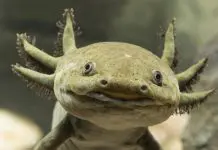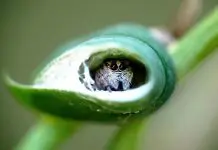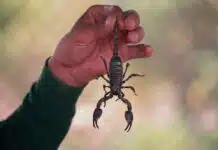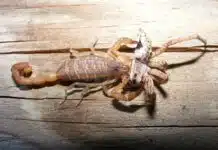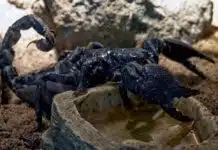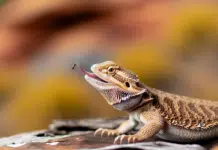An arachnid introduction: jumping spiders
People often say that first impressions are the most lasting and this is no exception when it comes to the next creepy crawly we are about to introduce to you. Upon first look, this arachnid would send chills down to kids and women of all ages whenever they were to encounter one.
Hairy body with outstretching appendages, a unique set of forward facing large eyes arrangement, the jumping spider’s quirky and unexpected behavior would most probably be the cause of why people are afraid of them.
As like all its other family species, the jumping spider’s characteristics are quite similar with its other arachnids species.
That fear of the unknown that a jumping spider instills in you whenever you were to encounter one, would most probably derive from their movements, as you never know where it might jump to, and land next.
What are jumping spiders?
In fact, most people consider tropical species of jumping spiders to be an insect and an annoying pest. I would like to clarify and clear the air by sharing more about these little arachnids as we go along. Jumping spiders do not belong to the insect family, instead, they are being classified as arachnids.
Difference between spiders and insects
The difference between a spider and an insect, for instance, an ant would be their body parts. Spiders have two body parts while insects have three.
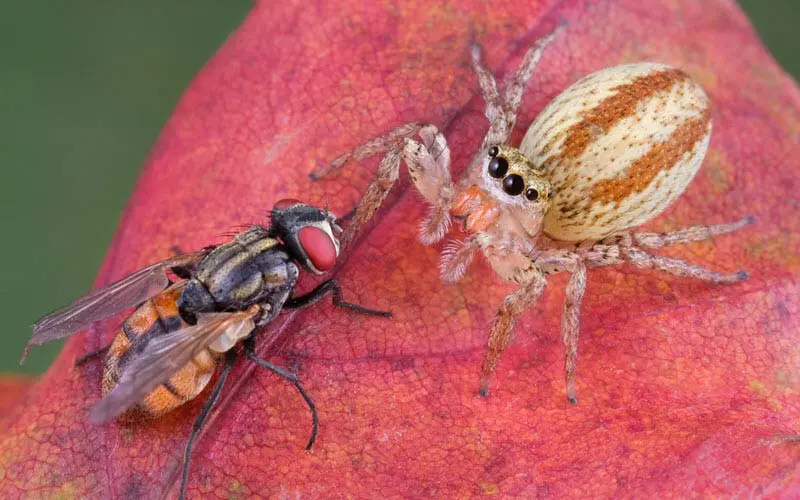
Spiders have eight legs while insects have six. When it comes to their body parts, insects would have 3 major body parts consisting of the head, thorax, and the abdomen, whereas for the spider, their heads are combined and fused with their thorax, which is being considered as one body part, following with its abdomen.
Besides having different physical features, spiders have the ability to spin web while insects are not able to. But one thing’s for sure, most insect has the ability to fly as most of them are armed with wings, whereas spiders are able to jump only.
The stereotype of a jumping spider
No doubt they may seem a little intimidating due to the fact that we are not able to predict its movements at all, these little creatures have been made the number one public enemy of all times, whenever we were to get a small bite or a sting.
All along, humans have generally considered jumping spiders to be a nuisance and find them repulsive because they are very alien-like, and if possible avoid it at all costs. The stereotype that any spiders would get upon sight is that they are poisonous and creepy, do not get in physical contact with them.
Although spiders are equipped with fangs and they can bite, but in this case of the jumping spider, they are not harmful to us humans at all, they are the kinds that would flee from danger rather than to attack. But at times, if they were to feel threatened or bullied, they will not hesitate to defend themselves by biting.
Most of the time, at any given feeding opportunity, even if they had the chance to, they would not draw blood or try to bite humans at all. Their natural source of food is smaller insects that they can fit into their mouth. They do not feed on blood or bite as a sport.
Jumping spiders are being sought after as pets as they are considered adorable to some. Cute, can often be associated to the word “helplessness” and like babies and other newborn animals, we learn to think that a spider of that size with big beady eyes, short legs and a perception of helplessness makes it look adorable and that is why people would want them as pets to care for them.

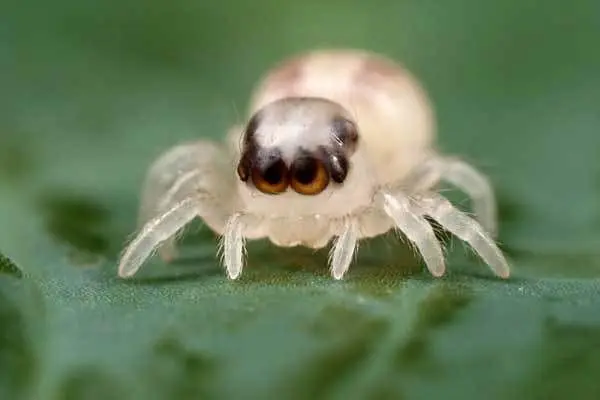
Don’t these young spiders look simply adorable and cute, I’m sure some of you would go “awwwwww”.
Let’s take a look at some of the most popular species of common jumping spiders species which are perfectly fine to be kept as pets.
Types of jumping spiders
There are simply too many hybrid of different species and variants when it comes to jumping spiders, but here I will be introducing 8 of the most common jumping spiders species which can be kept as pets.
1. Phidippus Audax (Bold Jumping Spider)
The Phidippus Audax, also known as the bold/daring jumping spider got its nickname due to the fact that they have a bold personality where they are not introverts that will shun away. Most of the bold jumping spider is mostly covered in black, with their distinctive front two chelicerae (fangs) usually coated in a bright metallic green or blue. Apart from its color, it does looks similar to the regal jumping spider.

These spiders are a common type of spider species in the wild in North America or in open areas as they like to actively seek out for their preys instead of spinning webs and playing the waiting game. Their diet consists of smaller spiders/insects and wingless fruit flies and they have been known to jump at least 10 to 50 times their body length with the help of additional blood pressure pumped into their third or fourth pair of legs.
2. Phidippus Regius (Regal Jumping Spider)
The Regal Jumping Spider or phidippus regius is considered to be a large species which can be found in eastern North America, else in open fields or even trees and walls of buildings. The adult males can be easily differentiated from the females especially as they often come in a black base with a unique pattern of white spots and stripes, whereas for the female spider, they would carry a somewhat similar pattern but their colour ranges from gray shades to vivid oranges. Their diet ranges from small insects to small crickets. The regal jumping spider would spin silken nests and sleep in them when night falls and the females will lay their eggs under tree barks or secluded areas such as barns.
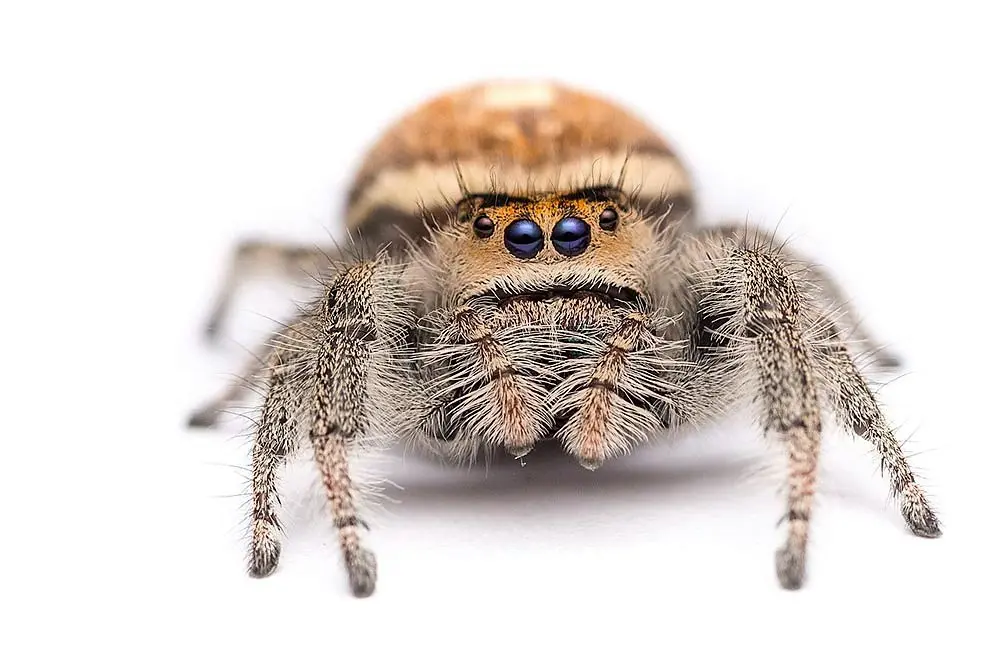
Regal jumping spiders or phidippus regius also makes a capable predator. Their keen eyesight, paired with their agile hunting skills, makes them a marvel to observe. These spiders are not just hunters but also performers, often engaging in intricate dances to communicate or woo a potential mate. The regal jumping spider curious nature and interactive behavior with their environment make them a delightful pet, offering endless moments of fascination for their owners. Moreover, their minimal care requirements and non-aggressive nature make them suitable even for those new to the world of arachnid companionship.
3. Platycryptus Undatus (Tan Jumping Spider)
Platycryptus Undatus, also known as the Tan Jumping Spider, can be found in Canada and the US, or even in tree barks and tight crevices. It is primarily covered in a tan colour, that is probably how it got its name. They have a prominent pattern which comes in orange on its abdomen and thorax. They feed on smaller insects, earthworm, and small crickets. These little guys have been known to NOT be shy around humans. They can be typically scooped up in on your palms and curiously wonder around. But be sure not to pinch or squeeze it, as you will be prone to their defensive bite.

4. Salticus Scenicus (Zebra Jumping Spider)
The Zebra Jumping Spider, quite self-explanatory how it got its nickname from based on the zebra-like stripes all over its thorax and abdomen. They can be found all across Britain, Europe and north America. This species of Jumping spiders have urbanized themselves and can be also found in human settlements or indoors at times. The Zebra jumping spider, like the regal jumping spider have been known to prey on smaller spiders and insects. Their hunting behavior has been described to be quite cat-like, gauging the distance and with the right amount of strength, pouncing onto their prey as accurately as possible.
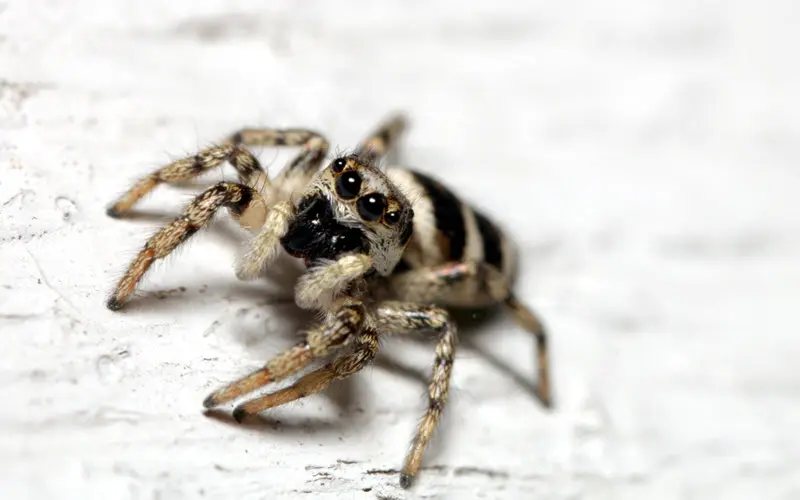
5. Chrysilla Lauta (Elegant Golden Jumping Spider)
I guess we can all tell where this jumper got its nickname from. The elegant golden jumping spider, which can be found mainly in rain forests from China, Vietnam, Burma, Myanmar, and Singapore. Coming in shades of red, blue, and yellow especially around its thorax, majority of its body is coated with a golden bronze overall. This jumper’s diet mainly consists of flightless fruit flies, smaller insects and smaller spiders.
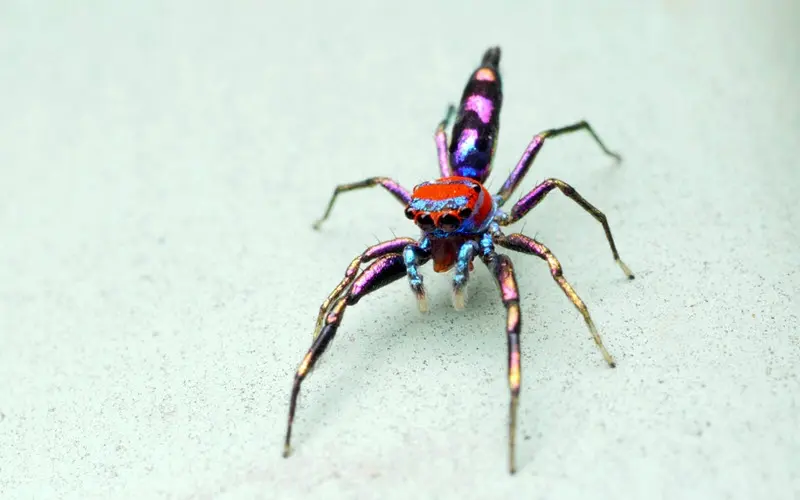
6. Cosmophasis Umbratica (Shiny Jumping Spider)
The Cosmophasis Umbratica got its nickname also from its physical features where they are able to reflect UV from almost all of its body parts during UV interaction and can also display extreme dimorphism when being exposed to UV lights. This is a sign of sexual signalling and this rare phenomenon occurs with butterflies as well. This species of jumping spider can be found in India and Sumatra, sometimes even on plants that are exposed to direct sunlight in the late mornings and early afternoons where hot hot direct sunlight is at its peak. These UV sensitive jumping spider’s diet revolves around smaller insects like ants and flies.
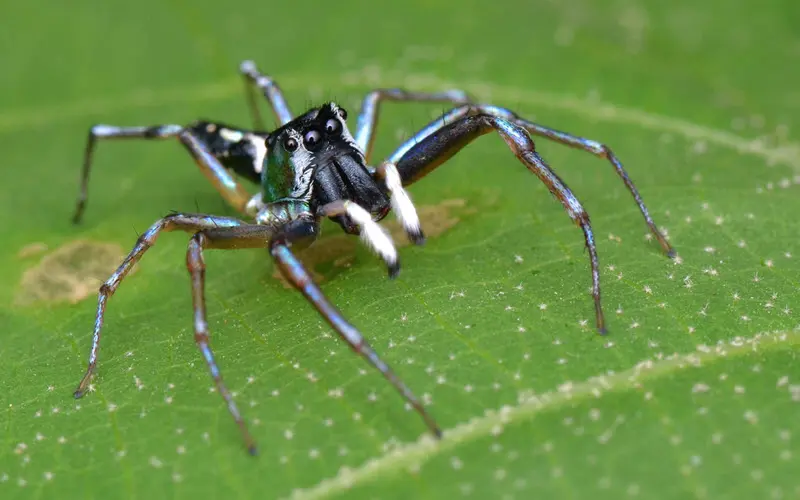
7. Hyllus Diardi (Heavy Jumper)
The Hyllus Diardi also known as a heavy jumper gained its reputable name through how it accurately jumps onto its prey, the impact after it lands is somewhat heavy, hence gaining the undisputable nickname; the heavy jumper. This spider is mostly covered in thick white fur and can be found in mangrove areas. The heavy jumper has been reportedly sighted in countries such as Thailand and Singapore, where its diet mainly consists of flies and crickets which you can get from local pet stores. They are known to be one of the largest species of jumping spiders and their trademark would have to be that precision when they hunt for their prey.
A video of how the “heavy jumper” takes down its prey
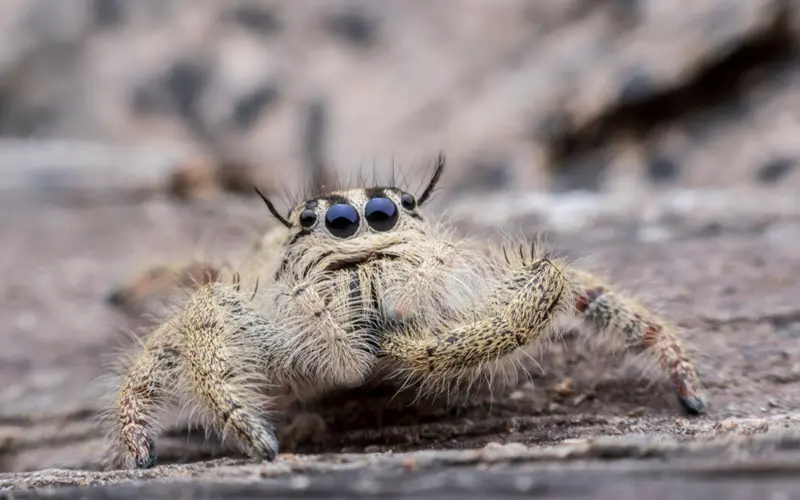
8. Portia Labiata (White-Moustached Jumping Spider)
Only found in Asian countries such as Sri Lanka, Singapore, Malaysia, Java, Sumatra, Philippines, India, Southern China, and Burma(Myanmar), the Portia Labiata is a medium-sized jumping spider that has its a distinctive two fangs coated in sparse white hair, which is most probably how it got its nickname the white-moustached jumping spider. Their diet comprises of fellow webbed spiders, other spiders and insects. They are able to adapt to any given situation and improvise accordingly while hunting and remember their new hunting approaches. Their hunting tactics are quite versatile and flexible like a lion.
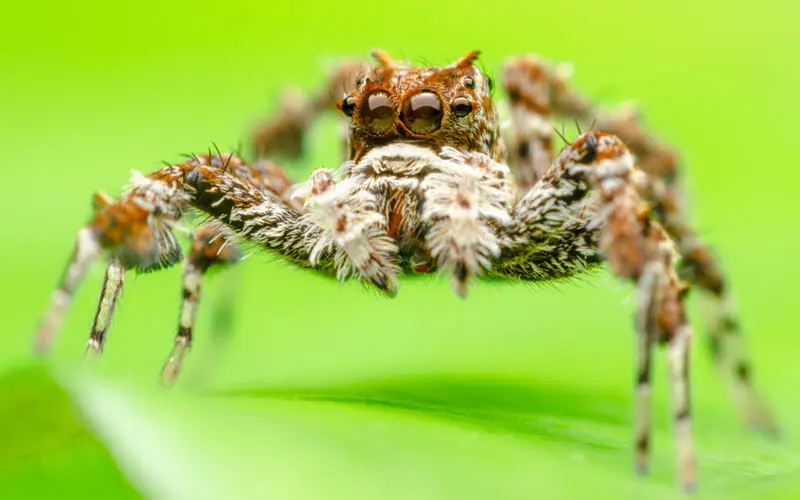
How to catch them?
If you want a pet jumping spider, try catching one! Jumping spiders are almost readily available everywhere. For starters, if there are nearby parks or gardens around you, that would be a good place to begin your search. In order to hunt for a jumping spider, you have to know how they move. Jumping spiders hunt their prey by foot instead of slinging around like Spiderman, hence the chances of you locating one jumping from plant to plant or through grasses would be high.
If you are out roaming in the park, chances are you may also encounter other insects and smaller creatures. It is always good to carry a sturdy stick or a wood branch to strike on bushes or cluster of leaves as it will alarm the jumping spider who are hiding in it and cause them to jump out into the open.
In order to catch one, you have to be able to tell the difference and recognize a jumping spider beforehand. Jumping spiders ranges from as small as 1mm to 25mm (0.1cm to 2.5cm), approximately a third of a section of a finger biggest.
Once you are able to identify one, bring along a small container or a bottle that has been washed thoroughly and completely dried to temporarily house them while transiting back to your house. While coaxing a jumping spider into your vial or container, be patient as it requires a certain amount of effort to do so as they are small and can be tricky to capture.
Try to use twigs, bottle caps, or container lids to guide it in and avoid using your hands and fingers if possible. Even though there has been no record that jumping spiders have caused death, but they can still bite and it is still a mystery whether their venoms are indeed poisonous or not.
Be sure to read our blog on how to catch jumping spiders before you proceed to make your capture, it is always better to be safe than sorry or go through unnecessary lengths when instead there are tips and tricks provided to capturing a jumping spider that much easier.
Keeping them as pets
Can jumping spiders be kept as pets? Why of course they can! Jumping spiders are excellent pets as they are not as sensitive like fishes where temperature and the water perimeters have to be kept in a certain fashion.
Create the right habitat for them to thrive in as they are able to adapt almost anywhere. As long as you have a tank, a terrarium, a glass/jar or a clean enclosure with ample space for it to roam around, at least a cubic foot in size, it will be just about right for the jumping spiders to live in.
Some examples of suitable housing for a pet jumping spider:
- Simple kritter keeper with lid
- Acrylic Terrarium Container
- Acrylic Sliding Container for easy feeding
- Portable Transparent Plastic Box
- Exo Terra Wide Terrarium with front window
Like any other insects and creatures we keep as pets, these jumping spiders needs an adequate space and ventilation for them to breathe.
Because of its curious nature to explore and jump around out in the while, you need a lid to contain it, else your pet jumping spider will be out of its enclosure the next morning. Ventilated small holes that allow proper ventilation and air flow is a must for them.
Get on Google or Youtube, search with keywords like “jumping spider pet enclosure, pet jumping spider, or even jumping spider tank.” Search results will return with almost all sorts of the environment there is, but the underlying pattern that I couldn’t help but notice can be found almost anywhere.
Here is some stuff that you are able to pick out from the nearby woods and even from parks to replicate your terrarium to be as close to its natural habitat.
- Twigs to act as obstacles and branches
- Gravel or soil to act as the substrate for the tank
- A couple of rocks with holes and openings so they can hide in there
- Big pieces of leaves that are found around most trees
For those of you who have a knack for cleanliness, great news! Jumping spiders are quite homely pets, place small napkins, pieces of cloth or paper towel as a foundation for them to make their home, they will literally be resting in their spots most of the time and only hunt whenever food is being presented to them. Jumping spiders do not spin webs but they have their way of making themselves feel at home. Last but not least, have your terrarium placed at somewhere that does not have direct exposure to sunlight so as to not overheat your jumping spiders!
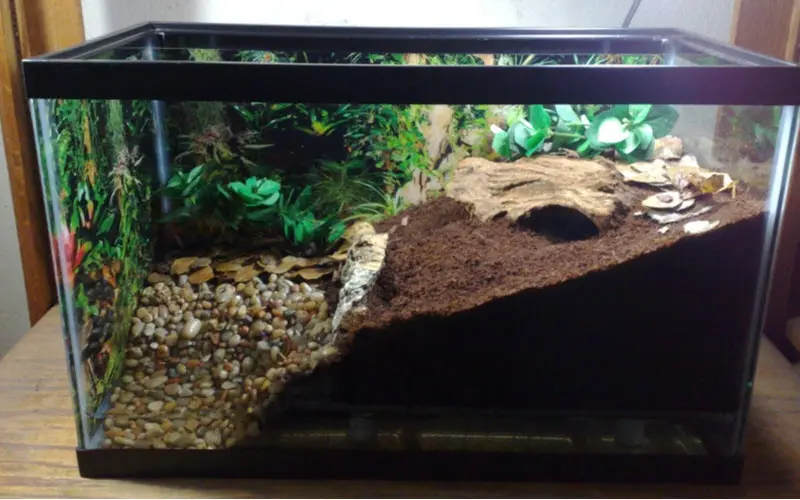
Man-made natural habitat
If you would like to learn how to set up a safe and natural environment for your pet jumping spider where they will feel most comfortable in, do head over to our jumping spider care guide to find out more!
Bottomline?
Jumping spiders make excellent pets for those who have limitations when it comes to space. Just because they come in all sorts of unique pattern and shapes does not mean that we can dismiss them to be alien-like and be afraid of them. Majority of the jumping spider species are not deadly and there have no reported incidents where jumping spider bites are lethal. With the stereotypes of jumping spiders being addressed and they would rather find a way to escape when in danger, there should not be any case of jumping spider bites unless they are being handled in a way where they feel threatened. Owning a jumping spider is relatively easy but it requires some effort to hunt for it once you are able to recognize it. Caring for a jumping spider is much easier as their diet can either be caught or bought from your local pet stores. Read up our Jumping spiders care guide to understanding more about these little arachnids.
If there are certain areas where you feel that we have left out/did not cover well or if you feel that there are sections we may have left out, do drop us a message under the comments section and we will address to your queries as soon as possible!
All The Best, and Happy Jumper Keeping!

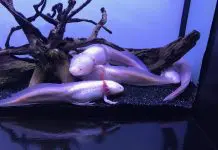

![Sick Axolotl, Fungus, Stress Symptoms [Axolotl Illness Guide 2025] Axolotl fungus](https://exopetguides.com/wp-content/uploads/2018/06/axolotl-218x150.jpg.webp)
